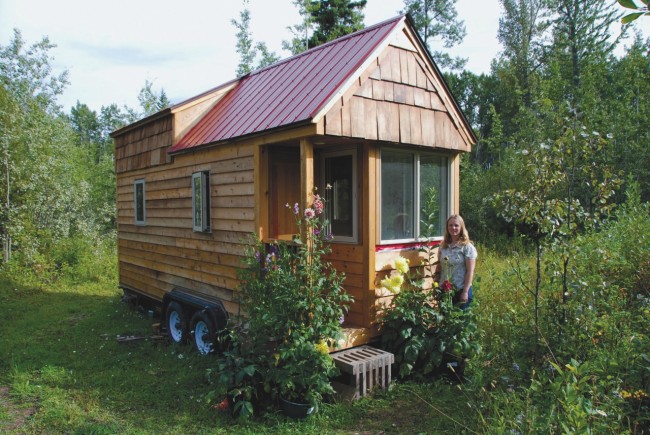
Long journey to a small space: Reflections on building a very tiny house
Finding the right housing situation to meet lifestyle choices, family needs and financial goals is a challenge that most people have struggled with at some point in their lives. Tired of renting and having roommates but not quite ready to launch into the financial and ongoing maintenance commitments of home ownership, I stepped off the traditional housing market train three years ago and embarked on a mission to build a house that fits my life.
I was flipping through some building magazines at a friend’s house when I saw it: a tiny cabin perched on a set of wheels. “Eureka!” I thought: the housing solution that did not involve renting, buying land or having a mortgage, but still had me owning my own home.
It was the summer of 2009 and the daily news was full of reports on the sub-prime mortgage collapse and subsequent global financial meltdown. This global banking nightmare, far beyond the control of the average person, was the trigger for thousands of layoffs, skyrocketing personal bankruptcies and home foreclosures. Building a tiny house that didn’t need a mortgage seemed like a practical way to avoid taking on large debt and have fun with a novel and more sustainable solution. Simple living had always appealed to me, and with a personal goal of never owning a vacuum cleaner, this petite maison seemed like the perfect fit.
My journey started by ordering plans for the Tiny House ‘Fencl’ model from the Tumbleweed Tiny House Company. For extra insight and some practical tips I signed up for a Tiny House workshop taught by Jay Schaefer, the owner of the company and co-founder of the Small House Society. I was so inspired when I returned that I immediately ordered a flat-deck trailer. I reminded myself of Toad of Toad Hall: eyes glazed over and muttering to myself, I was fully immersed in my tiny house craze phase. I looked at plans, scribbled drawings on receipts and envelopes and pored over the Bargain Hunter for supplies. I put up posters looking for scraps of building materials that were otherwise headed for the landfill.
When my 10,000-pound dual-axle trailer arrived, I remembered that the pinnacle of my previous carpentry achievements amounted to building a backyard compost bin. It was definitely time to call in reinforcements.
Trade-offs I hired Gavin Then—handyman, carpenter and set designer—and together we redesigned the layout. The kitchen was expanded to include a pantry, stove with oven, and more counter space. Extra windows were added, the loft expanded and the bathroom taken out. With interior measurements of 6’9”x 18’ (minus a tiny six-square-foot porch), we had 115 square feet to manoeuvre everything into. Each feature was carefully considered against my list of priorities:
An organized cooking space that does not make me feel like I’m camping Lots of windows and views A place to read/write and work on the computer A cozy place to sleep
With space at such a premium, I traded the luxury of peeing indoors for a more functional kitchen. Making trade-offs like this made the process feel even more intentional. I was choosing a kitchen over a bathroom, and with that choice came all the benefits and drawbacks every time I had to use either space. Tiny living is all-in.
After getting over the fear of accidentally attaching my hand to the floor or filling my skull full of nails (there’s a story on the Internet, I swear!), the air-nailer became my new best friend. KA-CHUNK, KA-CHUNK. Almost drunk with compressed air power, I was thrilled with my speedy progress—until I discovered there is no ‘undo’ button on a nail gun. Removing plywood air-nailed to a 2×4 frame mostly involves a lot of swearing and splinters. I ultimately decided that one window being one inch lower than the others would be just fine. (If anyone pointed it out, I would just give them a quizzical look and remark that it must be an optical illusion.)
Once lockup was achieved, finishing the inside was the next hurdle. Another benefit of hiring someone to work on the project with me was just to maintain momentum. It took about two years to complete the wiring, insulation, flooring, cabinets and other interior work, perhaps setting a new record for time spent building per square foot of finished living space. Thanks to friends and family who were willing to meet me for ‘construction dates,’ the tasks were slowly but surely checked off the list.
Finally, the building was trucked to the site and I was moving in. Determined to declare the project complete, I dragged the final toboggan-load of laundry and dishes to my doorstep on New Year’s Eve, 2011. Waking up on January 1 with the fireplace casting a cozy glow on the birch floor and snow falling outside, I felt victorious. I didn’t have everything I owned in the space, but I had what I needed. Clothes, kitchen-ware, food, some books and a coffee press. What more could I want?
Upsides and down As any do-it-yourselfer will agree, declaring the project finished and actually having finished everything are two different things. Rather than wait yet another year to move in after installing solar panels, drain field and an exhaust fan, I hauled batteries and water, and wiped condensation off the inside of the windows all winter in a new routine that was part meditation in off-grid living and part penance for not doing it right in the first place.
According to popular psychology, a new task consistently performed for 21 days becomes a habit. Soon, lugging batteries and propane bottles on a plastic toboggan through the snow felt as seamless as brushing my teeth. Well—almost. There was only one morning I could see my breath when the propane ran out in the middle of the night.
Almost a year later, the quirks of living in 115 square feet off the grid have either been worked out and improved, or worked into my lifestyle. Waking to the sound of rain on the roof a few feet above my head, and watching the deer walk past my window as I am eating breakfast in the morning, are as true to the romantic vision of the project as I could want. An unintended upside is that I spend more time outside. However, all arrangements have downsides, and I unexpectedly spend more time in my car than I used to, hauling batteries, laundry, and propane, counter to the eco-friendly lifestyle I figured would be automatic with a tiny housing footprint.
An additional twist to this story since I started the project is that I now have two more people to fit into my tiny house: my boyfriend Greg and his nine-year-old daughter Claire. We head out to my place for weekends, and with three people in 115 square feet it is a bit trickier. One of us cooks dinner while the other reads the paper aloud or hauls water, and Claire crawls up into the loft where she can play or, in her words, “just be cozy.” Before bed, we take turns brushing our teeth, filing in and out of the galley kitchen trying not to trip each other.
Now I feel that the tasks left to do are jobs to be savoured, as each item struck off the list is one step closer to the journey being over. However this space is used in the future—as a weekend retreat, an office, an extra bedroom, or maybe a retail outlet for a small business (Cottage Cheese? Mini-Donuts?)—I know that the building I created as a Tiny House will continue to expand the possibilities in my life.



